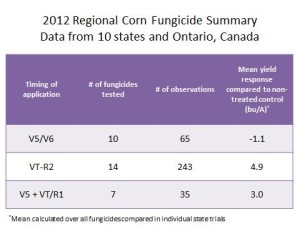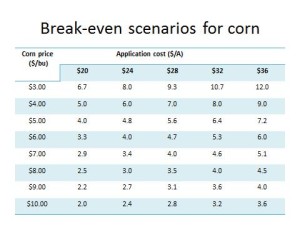With the earliest planted corn in Tennessee tasseling, corn should be scouted for diseases which are key factors when considering fungicide application
Major corn diseases are favored by humid conditions, so the edges of fields will not be the place to scout. Within fields, especially low spots that hold moisture are good areas to scout for disease as it may develop in those areas first. Be on the lookout for lesions and use the resources on UTCrops.com and particularly under Corn Diseases in the photo gallery (Corn Diseases in Tennessee) which contains disease images and weather conditions that favor disease development.
The most common foliar corn disease in Tennessee is gray leaf spot (caused by a fungus – Cercospora zea-maydis), especially in continuous corn fields. Other diseases that may be seen include anthracnose leaf blight (caused by a fungus – Colletotrichum graminicola), Northern corn leaf blight (caused by a fungus – Exserohilum turcicum), Southern corn rust (caused by a fungus – Puccinia polysora), and common corn rust (caused by a fungus – Puccinia sorghi).
There have been and still are small circular spots on corn leaves that can be Gramoxone (paraquat) injury or Holcus spot (caused by a bacterium – Pseudomonas syringae pv. syringae) or a mix of both Gramoxone injury and Holcus spot. Regardless, nothing needs to be done as both Gramoxone injury and Holcus spot do not usually affect yield and fungicides do not have any effect on bacteria. When in doubt don’t hesitate to contact your local county agent for advice on disease management and identification.
Deciding to apply a fungicide to corn should be based upon multiple factors including:
- Disease presence
- Weather conditions
- Cropping history
- Hybrid
Foliar fungicide applications in corn is more likely to provide an increase in yield when disease is present or there is significant risk of disease, weather conditions favor disease development, the field is corn after corn, and a disease susceptible hybrid is planted. Research data from University of Tennessee and other universities has continuously found these factors to strongly influence the magnitude and consistency of yield response to a foliar fungicide application in corn. Corn fungicide trials from 2010 through 2012, at the Milan Research and Education Center, conducted by Dr. Melvin Newman, reported only a significant, 15 bu/a increase in yield over untreated corn in 2010 (see last paragraph and graphs in previous article: Expected Outcome of Fungicide Applications at Early Vegetative Corn (V5-V6 Growth Stages).
When factors warrant a fungicide application, the application timing that has provided the most consistent yield increase over untreated corn is a fungicide application at VT or R1 growth stages (tasseling to pollination). Two tables are below from the 2012 Regional Corn Fungicide Summary data from the Corn Disease Working Group (CDWG), compiled by Drs. Kiersten Wise and Greg Shaner from Purdue University. The mean yield response of fungicide applications compared to non-treated control from 10 states and Ontario, Canada was -1.1 bu/a with applications at growth stage V5/V6, 4.9 bu/a with applications at VT-R1 (tasseling to pollination), and 3.0 bu/a with applications at V5/V6 plus a VT-R1 application (first table). Keep in mind this is across areas with variable weather conditions, field histories, and varying disease pressure.
The increase in yield to break-even on fungicide application can be found in the second table. Using a wide net of break-even scenarios based on past average corn prices and $24 to $36 application costs an increase of 3 to 5 bu/a would be required.
There are multiple fungicides labeled for corn and for the control of different diseases. The multistate collaborative, the Corn Disease Working Group (CDWG), has developed information on fungicide efficacy for control of certain corn diseases. This corn fungicide efficacy table can be found at UTCrops.com (Corn Fungicide Table – CDWG). Application coverage is also important, which includes using sufficient amount of water per acre and adequate droplet size based on the product being applied.



